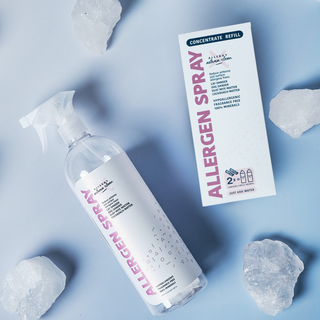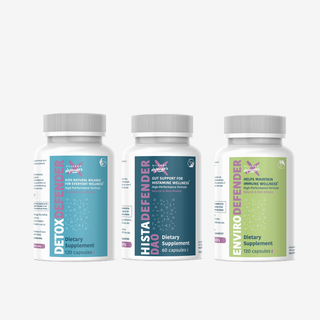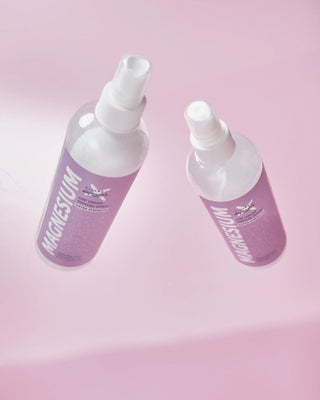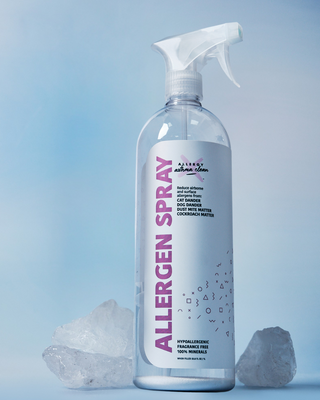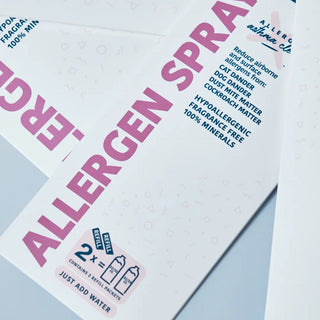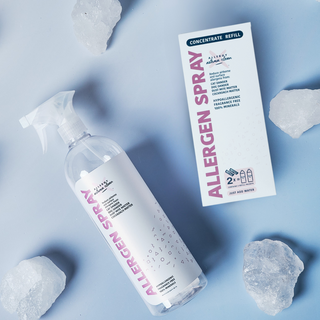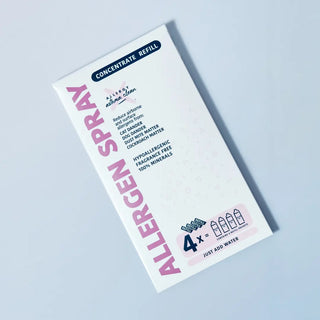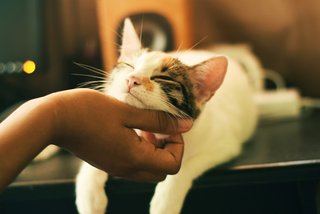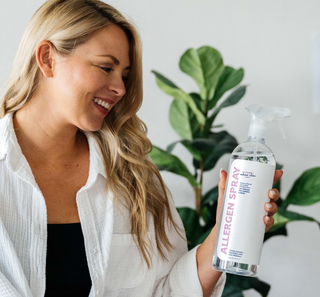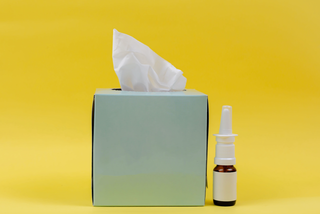Wondering what actually kills allergens in the air? True allergen control means tackling both airborne and surface triggers. Allergy Asthma Clean Allergen Spray by Allergy Defender is a mineral-based, non-toxic solution proven to reduce up to 95% of airborne allergens and 99% on hard surfaces—including pet dander, dust mites, and cockroach matter. Unlike air purifiers that only trap what’s already floating, this spray deactivates allergens at the source. Combine it with HEPA filtration, humidity control, and regular cleaning for comprehensive, natural allergy relief and cleaner, healthier air at home.
Key Takeaways
-
Use Allergen Spray – Allergy Asthma Clean Allergen Spray by Allergy Defender neutralizes allergens in the air and on surfaces, reducing up to 95% airborne and 99% surface allergens. It’s mineral-based, fragrance-free, and safe for families and pets.
-
Add HEPA protection – Air purifiers and vacuums with HEPA filters trap dust, pollen, and dander already in the air but don’t stop allergens from resettling. Use in tandem with Allergen Spray for full control.
-
Clean weekly – Vacuum carpets and upholstery using a HEPA-equipped vacuum. Wash bedding in hot water (130°F+) to eliminate dust mites and allergens.
-
Control humidity – Maintain indoor humidity between 40–50% with a dehumidifier to prevent mold and dust mite growth.
-
Natural helpers – Low-pollen plants like Peace Lily and Snake Plant can help freshen air. Nasal irrigation with saline also provides non-drug allergy relief.
-
Holistic approach – The best results come from combining Allergen Spray, HEPA filtration, smart cleaning, and humidity balance—creating a cleaner, allergen-reduced home environment
You're allergic, right? Something's bothering you at home. Ever wonder what kills allergens in the air? Allergen spray, HEPA air purifiers, and proper humidity control are great tools. These methods help reduce dust mite and pet dander allergens, and more, ensuring cleaner air and a healthier you.
Key Takeaways
-
Use Allergen Spray to reduce up to 95% of airborne allergens. Made with natural ingredients, it’s as simple as spraying the inside of your home for cleaner, fresher air. It's a powerful, science-backed solution.
-
Use HEPA (high-efficiency particulate air) purifiers and HEPA filter-equipped vacuums to control allergen accumulation and maintain a healthy living environment.
-
Clean weekly. Frequently wash bedding.
-
Maintain optimal humidity levels (no higher than 50%).
-
Certain indoor plants could enhance indoor air quality. Nasal irrigation can be used to help reduce allergies without drugs
Can Allergen Spray Work On: What Kills Allergens in the Air?
Allergen Spray is formulated to reduce the presence of allergens both in the air and on various surfaces (tabletops, hard flooring, hardwood chairs, etc.). This spray has undergone independent testing to confirm it can reduce up to 95% of allergens originating from sources such as dust mites, pet dander, and cockroach allergens. Allergen Spray is the perfect solution if you're seeking a way to enhance your indoor air naturally. It can stop allergens from floating back into the air.
While HEPA-filter air purifiers can help capture airborne allergens like pollen and dust, they only trap particles already in the air, leaving allergens on surfaces untouched. Allergy Defender’s Allergen Spray goes further by drying up allergens at the source, preventing them from becoming airborne in the first place. This approach creates a healthier environment throughout your home, offering more comprehensive protection than air purifiers alone.
How Allergen Spray Works
Our unique mixture (when you add water to the bottle) attracts and attaches to allergens in the air and on surfaces. The spray brings them down to the ground, dries them out, and negates them with minerals. This creates an invisible protective barrier that prevents allergens from escaping back into the air, reducing exposure and creating a more allergen-free living space.
Reduces up to 99% of Major Allergens on Hard Surfaces
Based on the results from surface samples collected from multiple testing procedures, Allergen Spray effectively reduces the number of allergens from dust mite, cockroach matter, and cat and dog dander from surfaces after being treated.
Reduces up to 80% to 95% of Major Allergens in the Air
Based on the results from testing air samples collected from an environmental chamber, Allergen Spray effectively reduces the dust mite, cat, and dog allergens after being sprayed in the air.
Can HEPA Filters Work On: What Kills Allergens in the Air?
HEPA filters are designed to enhance indoor air quality by capturing a wide array of harmful particles in the atmosphere. By pushing air through a tightly woven mesh, these filters effectively seize minuscule particulates such as dust, pollen, and pet dander. Authentic high-efficiency particulate air (HEPA) filters undergo rigorous testing to confirm their capability of intercepting 99.97% of airborne particles that are as small as 0.3 microns in diameter, establishing them as highly efficient tools for diminishing airborne allergens. The incorporation of a HEPA filter can greatly amplify this filtration efficacy.
When added to appliances like air purifiers or vacuum cleaners, HEPA filters play an essential role in helping improve indoor air quality. These devices offer relief for allergy sufferers because they help reduce allergens within your home.
3 Things to Do Before Choosing a HEPA Air Purifier
Before making a decision on an air purifier, verify it has a HEPA filter. It's your guarantee that the air purifier has the ability to reduce indoor allergens in your environment efficiently.
It’s also important to measure the room in which you intend to use the purifier.
A Clean Air Delivery Rate (CADR) on the unit gives you insight into how quickly an air purifier cleans the air, depending on the size of the room. To ensure maximum efficacy in eliminating allergens, make sure that the CADR aligns well with your intended room dimensions.
In summary:
-
Measure your room to figure out which unit you should purchase. Small units can't clean big rooms well.
-
Make sure a HEPA filter is included in the air purifier to help clean widespread indoor airborne particles and allergens effectively.
-
Verify that CADR matches up appropriately with room proportions for peak removal regarding airborne allergens.
Opting for an air purification system furnished with both a HEPA filter and a compatible CADR measurement promotes better indoor air quality while reducing the impact of allergies.
Can Regular Cleaning Kill Allergens in the Air?
A regular cleaning routine is pretty darned essential for managing indoor allergens. Allowing dust and allergens to gather can worsen allergy symptoms. Consistently cleaning keeps the buildup of allergens at bay, supporting a more healthful home.
To target those indoor allergens, concentrate on areas where they tend to collect most frequently, such as where pets hang out, in crevices of furniture, and in your bedding. Launder items like bed linens and draperies. Such steps enhance the overall quality of indoor air by keeping potential allergy triggers low. Cleaning by itself cannot kill allergens in the air.
Vacuuming with HEPA-Equipped Vacuums
Employing a vacuum cleaner equipped with a HEPA filter can drastically diminish the accumulation of dust mites and pet dander within your living space. The design of HEPA vacuums allows them to capture allergens that standard vacuum cleaners may overlook. To mitigate allergens and bolster indoor air, it is advisable to vacuum carpets and upholstery regularly, at least once a week.
Vacuums certified as Asthma & Allergy Friendly® are particularly adept at minimizing allergens.
Wash Bedding and Curtains
Regular washing of bedding and curtains is essential for removing allergens and reducing dust mite populations. Bedding should be washed weekly in hot water, ideally at temperatures of at least 130 degrees Fahrenheit, to minimize allergens effectively. Curtains should be cleaned seasonally in hot water to manage allergen levels.
Can Humidity Levels Kill Allergens in the Air?
Regulating humidity levels helps to effectively manage indoor allergens. Work to maintain indoor humidity levels within the range of 40% to 50%.
Using dehumidifiers and ventilation fans in kitchens and baths aids in balancing moisture levels indoors; in other words, it can help reduce humidity levels in your home.
Ventilation Strategies
Enhancing air flow using exhaust fans can play a significant role in controlling indoor humidity levels and minimizing the accumulation of allergens. By deploying these fans, particularly in high-moisture areas such as kitchens and bathrooms, ventilation can be improved to decrease humidity and elevate indoor air quality.
By itself, keeping humidity levels low will not kill allergens in the air.
Will Allergen Barriers Work On: What Kills Allergens in the Air?
Bedding that is hypoallergenic, along with mattress covers resistant to allergens, can act as a good barrier against dust mites.
Setting up areas in your house where pets are not allowed (such as your bedroom) can play a helpful role in reducing exposure to pet dander.
Allergen barriers will not kill allergens in the air. It will help reduce your allergen load, though.
Dust Mite Proof Covers for Bedding
Mattress and pillow covers act as a barrier against dust mite invasions in your bedding. These protective enclosures serve to block out skin cells and other organic debris that dust mites typically like to consume, thus diminishing the likelihood of allergic responses.
Protective Measures from Pets
Establish areas in your home where pets are not allowed, such as bedrooms, to help minimize your pet dander allergic reactions. This practice reduces exposure to allergens and really lessens the overall amount of indoor allergens. Consider keeping pets off the furniture and or even outside to help decrease your pet dander allergy reactions.
By adopting these strategies, you can effectively manage your indoor allergens while enhancing a healthier home.
Alternative Ideas to Reduce Allergens
Have you thought of using houseplants to reduce allergens?
How about a natural method of reducing allergy symptoms?
Indoor Plants for Air Purification
Invite plants like the Spider Plant, Snake Plant, and Peace Lily into your living areas to enhance your indoor air quality. These particular species can help sift out harmful contaminants from the air in your home, thereby substantially improving the condition of indoor air. Introducing these natural purifiers can contribute to cleaner breathing spaces by minimizing allergens. The varieties mentioned are more hypoallergenic than other plants. They don't add pollen to the air and can help purify the air. Just be sure you maintain the plant. Don't overwater. Wipe dust off the leaves and prune the plant when needed to reduce the chance of dust mites.
By placing these green plants around your home, you create an ambiance that is both healthier and more inviting.
Nasal Irrigation
Using a saline solution for nasal irrigation can ease nasal congestion and discomfort, as well as expel allergens and mucus. Neti pots, squeeze bottles, or bulb syringes may be used to irrigate your nasal passages.
Using nasal irrigation as a daily habit has been shown to diminish allergy-induced nasal blockages as well as lessen the occurrence of headaches associated with allergies.
Effectively controlling allergy symptoms often takes a multifaceted approach that typically involves various medications.
Tackling indoor allergens demands an overall strategy that encompasses the use of Allergen Spray, HEPA air purifiers, along with cleaning routines and managing humidity. These measures are vital in enhancing indoor air quality. When these tactics are paired with suitable medications and treatments for allergies, they can deliver extensive relief from allergy symptoms.
Frequently Asked Questions
How often should I vacuum with a HEPA-equipped vacuum?
Vacuuming carpets and upholstered furniture weekly with a HEPA-equipped vacuum is crucial for effectively reducing allergens and maintaining good indoor air quality. Use Allergen Spray before and after vacuuming to control allergens that become airborne.
Regular maintenance will help ensure a healthier living environment.
What is the ideal humidity level for reducing dust mites?
To effectively reduce dust mite allergens, it’s essential to maintain indoor humidity levels between 30% and 50%. Keeping humidity within this range will significantly reduce dust mite populations.
Are there natural methods to reduce allergens in my home?
Yes, you can reduce allergens in your home by using Allergen Spray and by using HEPA HVAC filters and vacuum cleaners, and air purifiers.
Also, nasal irrigation with saline solution should be considered to alleviate symptoms effectively.

